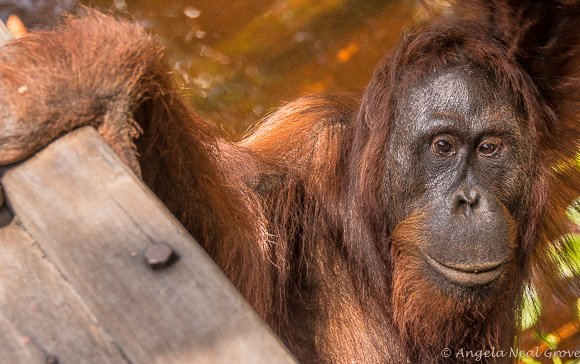
A year ago I was on the Orion, a boat bound for Borneo and the tiny port of Kumai. Kumai has the dubious distinction of being the birds-nest soup capital of the world. Soup production, however, was a side-show. Endangered orangutans were our quest. We were on an expedition arranged by Lindblad to see these primates in their home.

Destination Camp Leakey
From Kumai we headed along the coast and up the Sekonyer River to Camp Leakey. It was here in 1971, Dr. Birute Mary Galdikas founded the camp, and the Orangutan Research and Conservation Center.
A protoge of paleoanthropologist Louis Leakey, Galdikas, along with Drs. Dian Fossy and Jane Goodall, form a dedicated trio of women primatologists. Their ground-breaking research and work on primates is legendary.
Into Borneo’s interior
The Sekonyer River winds deep into the heart of Tanjung Puting,1,174 square mile national park jutting into the Java Sea. This prime orangutan habitat is also one of the worlds most ecologically diverse areas. It is home to pigmy elephant, clouded leopard, 600 species of birds and 15,000 species of plants.
We rode a klotok up the river, a traditional two-story wooden boat. From the top deck, looking in the dense jungle, we saw troupes of monkeys, hornbills and kingfishers. Crocodiles lurked in the reeds by the narrow waterway.
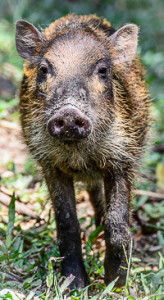
Welcome Party
Arriving at the camp an orangutan, hair gleaming deep copper in the dappled sunlight, appeared to be waiting for us. It swung up onto the wooden landing stage, brown eyes following us as we clambered ashore. We were up close with orangutans.
The ape may have been more interested in checking whether we had treats than being an official greeter, but the tone was set. High above, rustling in tree tops a family was clustered. A striped wild boar trotted into the undergrowth. Walking along the narrow path into the camp, with its cluster of wooden huts, other orangutans watched us, one munching on a mango.
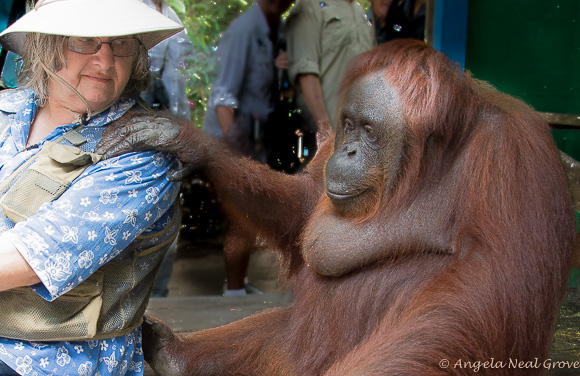
Dr.Galdikas was sitting on a wooden platform outside her home. She was surrounded by her wild family calling each by name. The mutual respect, connection and trust between them was palpapable.
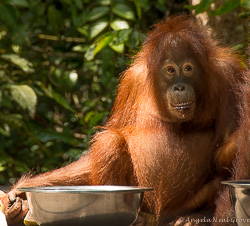
Many of these orangutans came to the camp as orphans destined for the pet trade, injured by loggers or rescued from poachers. One, recovering from injury, was being swung gently in a hammock by a volunteer.
Deforestation and Epic Battle to save Orangutans
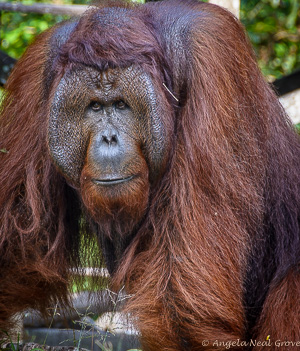
“Orangutans are in trouble and endangered,” said Galdikas, who, as president of Orangutan Foundation International, works tirelessly waging an epic ongoing battle to save the apes. Until fairly recently orangutans, which share 97% of our DNA, lived freely on the island.
Now 90% of Borneo’s ancient forest is gone, logged, cleared and planted with neat rows of palm trees for oil production. In 25 years Orangutans maybe extinct in the wild.
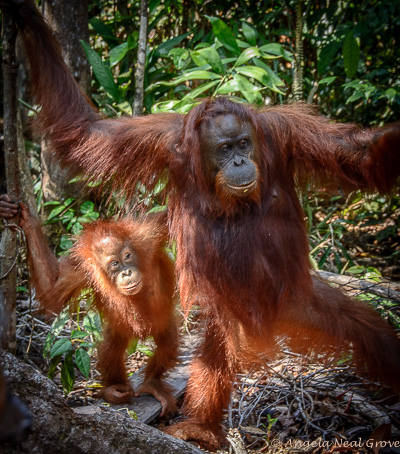
Feeding time
As we were talking with Dr.Galdikas, who has devoted her life to research and conservation of orangutans, we were interrupted. It was clear something urgent was happening. Orangutans seemed distracted, treetops were rustling.
Late afternoon is when volunteers pile bananas, mangos, durians and sugar cane onto a wooden platform in a clearing. It was feeding time and copper haired families were coming through the trees headed for the feast.
Mothers with babies clinging to their bellies, juveniles and imposing male orangutans with big cheek pads. An opportunistic Gibbon swung through the trees, grabbed a banana bunch and vaulted from tree to tree. We sat transfixed watching these magnificent creatures in their habitat.
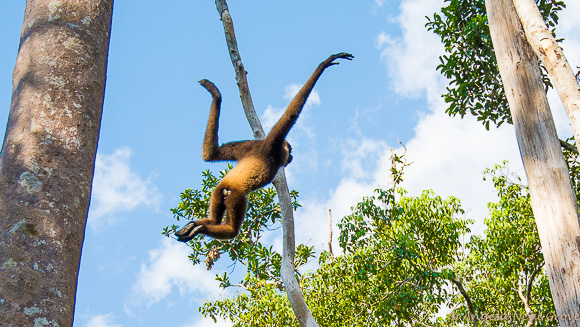
Return Journey

The sun was setting when we eventually returned to the Klotok – so named because it makes a klok tok tok tok sound. The forest on either side was alive with macaques, gibbons and huge endangered proboscis monkeys, their fur blending with tree trunks burnished golden in the setting sun.
A bottle of wine was produced and we toasted the scene, the day and the sunset. It was 4 hours back to Kumai but the forest sounds of the warm tropical night and the river were soothing.
The final show of the day was at the mouth of the river where thousands of fireflies circled and spun among the reeds in a magical light show.
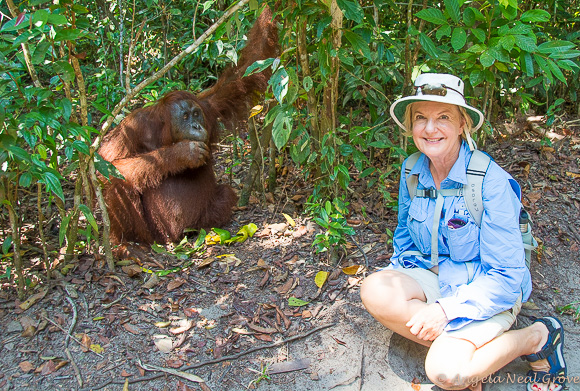
CLOUDY FUTURE FOR ENDANGERED ORANGUTANS – Palm Oil Plantations are the new Borneo
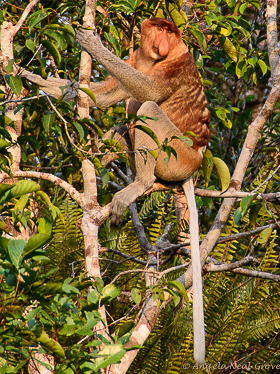
The day was bittersweet. Seeing the endangered orangutans in their natural habitat and talking with Dr. Galdikas at Camp Leakey was humbling and inspiring. However, long term prognosis for the apes in the wild is dismal due to logging, forest destruction and newly planted palm oil plantations where they are treated as pests.
Palm oil, used in myriad household and personal products, is now also seen as a potential bio-fuel. Returning to Singapore air quality was poor and hazy caused by smoke from burning and clearing of forests across Indonesia and Malaysia, reports stated.
How lucky we were to have been up close and personal with the endangered orangutans. How thankful we were to have learned about the oranutang’s plight on this Lindblad Expedition.
ACTION:
Click here to find out more about Palm Oil use everyday products and deforestation
Click here to find out about Orangutan Foundation International and how you can help or adopt a baby orangutan
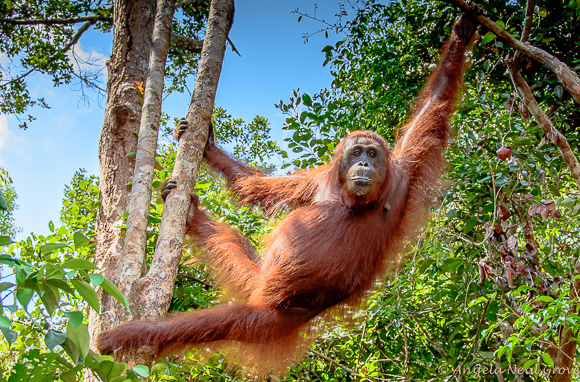
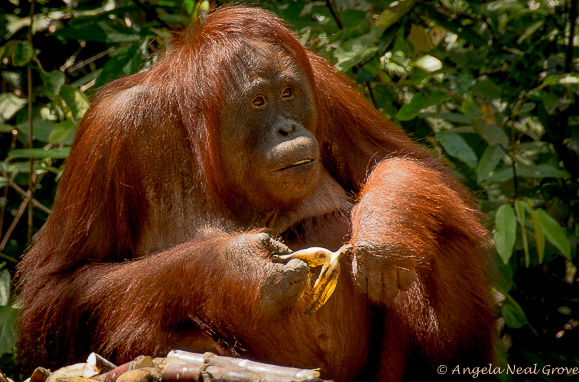
A fascinating and gripping report as usual. Your photographs are moving and insightful.
Thank you for sharing these amazing creatures. Best, Miranda
Thank you Miranda. It really was incredible to be so close with these primates, and to meet Dr. Galdikas and discover all she is doing. An experience which lingers. Angela
Wonderful pictures but a very disturbing message
Thank you for bringing this to our attention
Cathie
Yes, it was a bittersweet journey as you can tell. The desecration of the forests is so massive – one can only hope these orangutans continue to flourish in the wild area left to them.
Angela
Lovely, Angela. Thanks for sharing facts and photos.
eddy